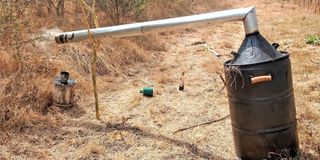Wood vinegar: The product that can earn charcoal makers more

The process of harvesting wood vinegar demonstrated in a photo taken in Kajiado. Wood vinegar has various uses including as an organic pesticide, fertiliser and animal feeds additive.
What you need to know:
- The non-water component of wood vinegar consists of wood tars, acetic acid, methanol, acetone and other chemicals.
- Wood vinegar improves fruit quality and increases their sugar content, flavour and colour. Seeds sprout faster when soaked in wood vinegar first.
- Husks of other crops such as coffee, coconuts as well as maize cobs and wheat straws can produce briquettes and wood vinegar.
- Studies show that in poultry, it eliminates salmonella bacteria responsible for gastrointestinal diseases in chickens improving egg-laying performance and hatching efficiency.
A key value addition product of modern charcoal production is wood vinegar. This is a liquid substance produced when smoke from the burning wood condenses via a metal chimney fixed on the kiln.
The non-water component of wood vinegar consists of wood tars, acetic acid, methanol, acetone and other chemicals.
It has various uses including as an organic pesticide, fertiliser and animal feeds additive. It is non-toxic and bio-degradable, thus its use in agriculture reduces the environmental pollution and health problems associated with fossil-derived pesticides.
Once the world’s preferred pesticide, wood vinegar was overtaken by synthetic ones from the petro-chemical industry. However, with the ever-growing demand for healthy living, it is making a comeback.
Its use in agriculture stimulates plant and fruit growth, enhances soil fertility and reduces weeds and pests.
Asia-Pacific countries dominate the wood vinegar market due to the growing agriculture, animal feed, and food and beverage industry.
Wood vinegar improves fruit quality and increases their sugar content, flavour and colour. Seeds sprout faster when soaked in wood vinegar first.
Asian countries such as India, Thailand, Vietnam and Japan that have adopted modern charcoal production are the leading global producers of wood vinegar.
Adjust bacteria levels
A study by Shelby Browning, Tom Lawrence, Chandni Joshi and Jeffrey Seay on the use of Croton megalocarpus tree nuts to produce wood vinegar in Kenya and published by the American Institute of Chemical Engineers in July, 2019, shows that maximum yields of the liquid occur at 450°C.
Increasing the starting moisture content of the husks increased both the percentage yield of vinegar as well as the amount of organic material extracted from the husks, the study also revealed.
Husks of other crops such as coffee, coconuts as well as maize cobs and wheat straws can produce briquettes and wood vinegar.
Teddy Kinyanjui of Woodlands Trust 2000 who sells wood vinegar at Sh500 a litre says: “It is produced by adding a simple metal pipe to a kiln (as shown above). You can harvest up to two litres from 100kg of wood.” For producers, this means income from charcoal can increase by Sh1,000 for every bag.
“The vinegar smells like smoke, and this repels pests because they think there is a fire,” Kinyanjui says. When mixed with animal feeds at rates of between 1:200, it can adjust bacteria levels in the digestive tract, which improves absorption of nutrients and, therefore, production.
Studies show that in poultry, it eliminates salmonella bacteria responsible for gastrointestinal diseases in chickens improving egg-laying performance and hatching efficiency.
Wood vinegar is also a livestock deodorant. The skin friendly plant chemicals bind themselves to odour-causing agents on the animal’s body and wastes, suppressing bacteria, viruses and other odour-causing pathogens. This results in healthier livestock and increasing yield.
With increased awareness and modern kilns, producers can make charcoal sustainably, maximise profits and help clean up the environment.




